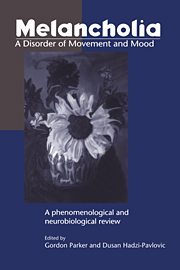Book contents
- Frontmatter
- Contents
- List of contributors
- Acknowledgments
- Introduction
- Part One Classification and Research: Historical and Theoretical Aspects
- Part Two Development and Validation of a Measure of Psychomotor Retardation as a Marker of Melancholia
- 5 Psychomotor Change as a Feature of Depressive Disorders: Historical Overview and Current Assessment Strategies
- 6 Development and Structure of the CORE System
- 7 Reliability of the CORE Measure
- 8 Validity of the CORE: I. A Neuroendocrinological Strategy
- 9 Validity of the CORE: II. Neuropsychological Tests
- 10 Validity of the CORE: III. Outcome and Treatment Prediction
- 11 Phenotypic Expression of Melancholia Contrasted for Those with Bipolar and Unipolar Illness Courses
- 12 Psychotic Depression: Clinical Definition, Status and the Relevance of Psychomotor Disturbance to Its Definition
- 13 A Clinical Algorithm for Defining Melancholia: Comparison with Other Sub-typing Measures
- 14 Rating the CORE: A User's Guide
- Part Three The Neurobiology of Melancholia
- The CORE Measure: Procedural Recommendations and Rating Guidelines
- References
- Author Index
- Subject Index
10 - Validity of the CORE: III. Outcome and Treatment Prediction
from Part Two - Development and Validation of a Measure of Psychomotor Retardation as a Marker of Melancholia
Published online by Cambridge University Press: 04 August 2010
- Frontmatter
- Contents
- List of contributors
- Acknowledgments
- Introduction
- Part One Classification and Research: Historical and Theoretical Aspects
- Part Two Development and Validation of a Measure of Psychomotor Retardation as a Marker of Melancholia
- 5 Psychomotor Change as a Feature of Depressive Disorders: Historical Overview and Current Assessment Strategies
- 6 Development and Structure of the CORE System
- 7 Reliability of the CORE Measure
- 8 Validity of the CORE: I. A Neuroendocrinological Strategy
- 9 Validity of the CORE: II. Neuropsychological Tests
- 10 Validity of the CORE: III. Outcome and Treatment Prediction
- 11 Phenotypic Expression of Melancholia Contrasted for Those with Bipolar and Unipolar Illness Courses
- 12 Psychotic Depression: Clinical Definition, Status and the Relevance of Psychomotor Disturbance to Its Definition
- 13 A Clinical Algorithm for Defining Melancholia: Comparison with Other Sub-typing Measures
- 14 Rating the CORE: A User's Guide
- Part Three The Neurobiology of Melancholia
- The CORE Measure: Procedural Recommendations and Rating Guidelines
- References
- Author Index
- Subject Index
Summary
Introduction
As noted in Chapter 2, suggested defining characteristics of melancholia have included selective response to physical treatments (i.e., antidepressant drugs and electroconvulsive therapy) in addition to clinical features. Again in that chapter, we noted support for the view of Ní Brolcháin (1979) that classification should be restricted “in the first instance, to mental state items,” before subsequently examining how aetiological and other factors (including treatment) relate to the clinically defined classes. In Chapter 6 we noted the reasons leading to revision of dsm-iii melancholia criteria, with Zimmerman, Black and Coryell (1989) pointing out that the dsm-iii criteria differentiated patients along a severity dimension, and that those criteria “did not predict treatment response.”
If melancholia and non-melancholic depression have differential naturalistic and/or treatment outcome patterns, and if the core measure is a valid measure of melancholia, then core scores should show predictive validity in outcome studies. Before reviewing several of our studies, we first note some evidence supporting differential outcomes for melancholic and non-melancholic depression.
The literature on naturalistic outcome is necessarily restricted by (i) the variable validity of criterion measures of melancholia or endogenous depression; (ii) intrinsic difficulties in measuring course of illness; (iii) co-morbidity issues – notably the presence or absence of anxiety, personality disorder and medical illness; (iv) non-illness variables – such as service access and sophistication; and by (v) varying definitions of the term “naturalistic.”
- Type
- Chapter
- Information
- Melancholia: A Disorder of Movement and MoodA Phenomenological and Neurobiological Review, pp. 160 - 171Publisher: Cambridge University PressPrint publication year: 1996
- 2
- Cited by



